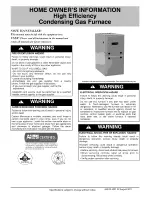
935SA: Installation, Start-up, Operating and Service Maintenance Instructions
Manufacturer reserves the right to change, at any time, specifications and designs without notice and without obligations.
23
Ductwork Acoustical Treatment
NOTE:
Metal duct systems that do not have a 90 degree elbow and 10
ft. (3 M) of main duct to the first branch take-off may require internal
acoustical lining. As an alternative, fibrous ductwork may be used if
constructed and installed in accordance with the latest edition of
SMACNA construction standard on fibrous glass ducts. Both acoustical
lining and fibrous ductwork shall comply with NFPA 90B as tested by
UL Standard 181 for Class 1 Rigid air ducts.
NOTE:
For horizontal applications, the top most flange may be bent
past 90
_
to allow the evaporator coil to hang on the flange temporarily
while the remaining attachment and sealing of the coil are performed.
GAS PIPING
Gas piping must be installed in accordance with national and local
codes. Refer to current edition of NFGC in the U.S.A.
Installations must be made in accordance with all authorities having
jurisdiction. If possible, the gas supply line should be a separate line
running directly from meter to furnace.
NOTE:
Use a back-up wrench on the inlet of the gas valve when
connecting the gas line to the gas valve.
For recommended gas pipe sizing (
). Risers must be used to
connect to furnace and to meter. Support all gas piping with appropriate
straps, hangers, etc. Use a minimum of one hanger every 6 ft. (2 M).
Joint compound (pipe dope) should be applied sparingly and only to
male threads of joints.
An accessible manual equipment shutoff valve MUST be installed
external to furnace casing and within 6 ft. (2 M) of furnace.
Install a sediment trap externally in the riser leading to furnace (see
). Connect a capped nipple into lower end of tee. Capped nipple
should extend below level of furnace gas controls. Place a ground
joint
union between furnace gas control valve and exterior manual
equipment
gas shutoff valve.
A 1/8-in. (3 mm) NPT
plugged tapping, accessible for test gauge
connection, MUST be
installed immediately upstream of gas supply
connection to
furnace and downstream of manual equipment shutoff
valve.
Piping should be pressure and leak tested in accordance with the current
edition of the
NFGC in the United States, local, and
national plumbing
and gas codes before the furnace has been
connected. After all
connections have been made, purge lines and
check for leakage at
furnace prior to operating furnace.
NOTE:
The furnace gas control valve inlet pressure tap connection
is
suitable to use as test gauge connection providing test
pressure DOES
NOT exceed maximum 0.5 psig (14-in. w.c.) stated
on gas control valve
(see
).
If pressure exceeds 0.5 psig (14-in. w.c.), gas supply pipe must be
disconnected from furnace and capped before and during supply
pipe
pressure test. If test pressure is equal to or less than 0.5 psig
(14-in. w.c.),
turn off electric shutoff switch located on furnace gas control valve and
accessible manual equipment shutoff valve before and during supply
WARNING
!
FIRE OR EXPLOSION HAZARD
Failure to follow this warning could result in personal injury, death,
and/or property damage.
Never purge a gas line into a combustion chamber. Never test for gas
leaks with an open flame. Use a commercially available soap solution
made specifically for the detection of leaks to check all connections. A
fire or explosion may result causing property damage, personal injury
or loss of life.
WARNING
!
FIRE OR EXPLOSION HAZARD
Failure to follow this warning could result in personal injury, death,
and/or property damage.
Use proper length of pipe to avoid stress on gas control manifold and
gas valve.
WARNING
!
FIRE OR EXPLOSION HAZARD
Failure to follow this warning could result in personal injury, death,
and/or property damage.
Gas valve inlet and/or inlet pipe must remain capped until gas supply
line is permanently installed to protect the valve from moisture and
debris. Also, install a sediment trap in the gas supply piping at the inlet
to the gas valve.
NOTICE
!
In the state of Massachusetts:
1. Gas supply connections MUST be performed by a licensed
plumber or gas fitter.
2. When flexible connectors are used, the maximum length shall
not exceed 36 in. (915 mm).
3. When lever handle type manual equipment shutoff valves are
used, they shall be T-handle valves.
4. The use of copper tubing for gas piping is NOT approved by the
state of Massachusetts.
WARNING
!
FIRE OR EXPLOSION HAZARD
A failure to follow this warning could result in personal injury, death,
and/or property damage.
If local codes allow the use of a flexible gas appliance connector,
always use a new listed connector. Do not use a connector which has
previously served another gas appliance. Black iron pipe shall be
installed at the furnace gas control valve and extend a minimum of 2-in.
(51 mm) outside the furnace.
CAUTION
!
FURNACE DAMAGE HAZARD
Failure to follow this caution may result in furnace damage.
Connect gas pipe to furnace using a backup wrench to avoid damaging
gas controls and burner misalignment.
















































